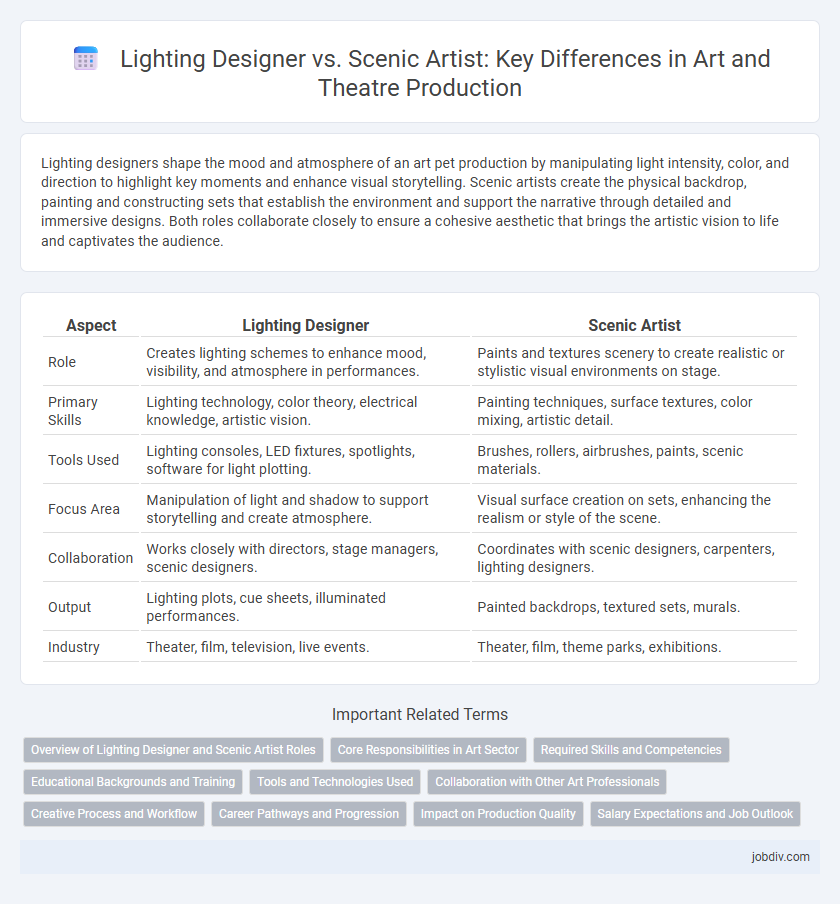Lighting designers shape the mood and atmosphere of an art pet production by manipulating light intensity, color, and direction to highlight key moments and enhance visual storytelling. Scenic artists create the physical backdrop, painting and constructing sets that establish the environment and support the narrative through detailed and immersive designs. Both roles collaborate closely to ensure a cohesive aesthetic that brings the artistic vision to life and captivates the audience.
Table of Comparison
| Aspect | Lighting Designer | Scenic Artist |
|---|---|---|
| Role | Creates lighting schemes to enhance mood, visibility, and atmosphere in performances. | Paints and textures scenery to create realistic or stylistic visual environments on stage. |
| Primary Skills | Lighting technology, color theory, electrical knowledge, artistic vision. | Painting techniques, surface textures, color mixing, artistic detail. |
| Tools Used | Lighting consoles, LED fixtures, spotlights, software for light plotting. | Brushes, rollers, airbrushes, paints, scenic materials. |
| Focus Area | Manipulation of light and shadow to support storytelling and create atmosphere. | Visual surface creation on sets, enhancing the realism or style of the scene. |
| Collaboration | Works closely with directors, stage managers, scenic designers. | Coordinates with scenic designers, carpenters, lighting designers. |
| Output | Lighting plots, cue sheets, illuminated performances. | Painted backdrops, textured sets, murals. |
| Industry | Theater, film, television, live events. | Theater, film, theme parks, exhibitions. |
Overview of Lighting Designer and Scenic Artist Roles
Lighting designers create and control the visual atmosphere of a production through strategic use of light, enhancing mood, focus, and depth on stage. Scenic artists develop and paint backdrops, props, and set pieces, transforming blank surfaces into immersive environments that support the story. Both roles collaborate closely to ensure cohesive visual storytelling in theatrical, film, and live event settings.
Core Responsibilities in Art Sector
Lighting designers craft mood and atmosphere by manipulating light intensity, color, and direction to enhance theatrical and artistic presentations. Scenic artists create detailed backdrops, props, and set pieces through painting, sculpting, and texturing, supporting the visual storytelling on stage or in exhibitions. Both roles require collaboration with directors and production teams to ensure cohesive artistic vision and impact.
Required Skills and Competencies
Lighting designers require expertise in electrical systems, color theory, and computer-aided design software to create atmospheric effects that enhance stage performances. Scenic artists must possess strong painting techniques, surface preparation skills, and a deep understanding of materials and textures to realize detailed set designs. Both roles demand collaboration, creativity, and precise execution to support the visual storytelling of theatrical productions.
Educational Backgrounds and Training
Lighting designers typically hold degrees in theater design, lighting technology, or related fields, combining technical skills with artistic principles learned through formal education and hands-on internships. Scenic artists often pursue training in fine arts, painting, and set decoration, emphasizing traditional art techniques and material manipulation acquired from art schools or specialized workshops. Both careers require continuous skill development, but lighting designers prioritize technical lighting software and equipment mastery, while scenic artists focus on visual creativity and surface treatments.
Tools and Technologies Used
Lighting designers utilize advanced software such as Vectorworks and Capture for precise lighting plots and simulations, alongside LED and intelligent lighting fixtures to create dynamic atmospheres. Scenic artists rely on traditional tools like brushes, rollers, and sponges combined with modern airbrushes and digital projectors to execute detailed surface textures and scenic backgrounds. Both professions integrate emerging technologies, but lighting designers emphasize electronic control systems, while scenic artists focus on material manipulation and visual effects.
Collaboration with Other Art Professionals
Lighting designers collaborate closely with scenic artists to enhance the visual impact of a production, ensuring that lighting complements the textures, colors, and shapes created on stage. Scenic artists provide detailed painted backdrops and set pieces that serve as the foundation for lighting effects, working in tandem to achieve cohesive atmospheres and moods. This partnership requires frequent communication with directors, costume designers, and stage managers to align technical and artistic visions for seamless stage presentations.
Creative Process and Workflow
Lighting designers translate the emotional tone and narrative of a production into visual light elements through technical planning, color theory, and cue sequencing. Scenic artists focus on creating tangible, textured environments using paint, materials, and sculpting techniques to physically transform stage spaces and support storytelling. Both roles intersect in collaboration but differ fundamentally in medium and execution, with lighting emphasizing dynamic perception and scenic art prioritizing physical presence.
Career Pathways and Progression
Lighting designers typically begin their careers with formal training in theatrical design or technical theater, progressing from assistant roles to lead designers in theater, film, or live events. Scenic artists often start as apprentices or assistants in painting and set construction, advancing to senior scenic artist or art department supervisor positions within theater, film, and television productions. Both career pathways demand strong collaboration skills and deep knowledge of stagecraft, with progression influenced by experience, portfolio strength, and industry reputation.
Impact on Production Quality
Lighting designers shape the mood and atmosphere of a production through strategic light placement, color, and intensity, significantly enhancing visual storytelling and audience engagement. Scenic artists create detailed, realistic backdrops and set pieces that establish the production's environment, adding depth and authenticity to the performance. Both roles critically influence production quality by blending visual elements that support the narrative and elevate the overall aesthetic experience.
Salary Expectations and Job Outlook
Lighting designers earn an average annual salary between $50,000 and $70,000, with job growth projected at 10% over the next decade due to increasing demand in theater and live events. Scenic artists typically make slightly less, around $40,000 to $60,000 per year, but enjoy steady employment opportunities in film, television, and stage production environments. Both positions require specialized skills, yet lighting designers often benefit from higher pay and broader job prospects within the entertainment industry.
Lighting Designer vs Scenic Artist Infographic

 jobdiv.com
jobdiv.com